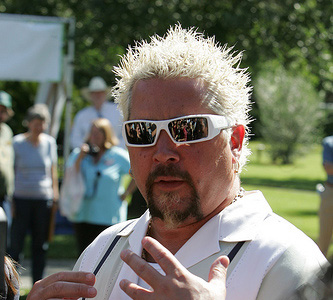When infamously snarky New York Times restaurant critic Pete Wells skewered Guy Fieri’s new Times Square restaurant last week, the controversy went viral.
Sarcastic questions targeting the quality of food and Fieri’s personality with harsh, punishing phrasing fill Wells’s review of the restaurant. Line after line of well-written negativity details the critic’s awful experience. Wells includes vicious quips such as, “Somewhere within the yawning, three-level interior of Guy’s American Kitchen & Bar, is there a long refrigerated tunnel that servers have to pass through to make sure that the French fries, already limp and oil-sogged, are also served cold?”
A negative review in the New York Times can crush a restaurateur and ultimately affect the business’s bottom line, but Fieri’s team was able to use the buzz to its advantage. Fieri traveled to New York City and appeared on Today, to rebut the review in a six-minute long segment.
During the segment, Fieri acknowledged that as a new restaurant, Guy’s American Kitchen & Bar is not perfect, but he also offered that the reviewer unfairly targeted the establishment to make a name for himself. The segment was filmed in his restaurant with examples of his food sitting on the table in front of him: a smart move.
Fieri calmly and clearly delivered his key messages, which he has maintained across media correspondences. In email messages and interviews, the Food Network host repeats that he stands by his food and staff, but he also recognizes that the review has given him something to think about. Fieri’s humble, down-to-earth demeanor will no-doubt earn his restaurant sympathy – and interest.
Is all publicity good publicity? It depends how your organization responds. Fieri’s team took the negative review as an opportunity to positively promote the restaurant on national television.
Fieri’s supporters will still pour into his eatery with enthusiasm while others may venture in just to see if it is truly as awful as Wells describes. In either case, diners are still filling tables.
Photo Credit: Flickr


 As design director at Cookerly, Tim serves as the creative lead in the development of branding campaigns, print collateral and digital media for clients across a broad range of industries, including consumer, professional services, healthcare and technology.
As design director at Cookerly, Tim serves as the creative lead in the development of branding campaigns, print collateral and digital media for clients across a broad range of industries, including consumer, professional services, healthcare and technology. As a senior vice president at Cookerly, Mike Rieman is a strategic communications leader specializing in media relations and reputation management. With a proven track record of securing high-profile placements in top-tier outlets such as The New York Times, The Wall Street Journal, CNN and USA Today, he excels at crafting compelling narratives that resonate across print, broadcast and digital platforms.
As a senior vice president at Cookerly, Mike Rieman is a strategic communications leader specializing in media relations and reputation management. With a proven track record of securing high-profile placements in top-tier outlets such as The New York Times, The Wall Street Journal, CNN and USA Today, he excels at crafting compelling narratives that resonate across print, broadcast and digital platforms. Mike Touhill is vice president at Cookerly Public Relations, where he helps lead traditional, social and digital media programs for B2B and B2C clients in packaging, telecommunications and technology, among other industries. As a communication leader, he develops and executes public relations strategy, provides proactive and reactive counsel to C-level executives and secures earned media coverage for client initiatives and product.
Mike Touhill is vice president at Cookerly Public Relations, where he helps lead traditional, social and digital media programs for B2B and B2C clients in packaging, telecommunications and technology, among other industries. As a communication leader, he develops and executes public relations strategy, provides proactive and reactive counsel to C-level executives and secures earned media coverage for client initiatives and product. Andrew Agan is a vice president at Cookerly Public Relations, overseeing the agency’s internship program and leading media relations, content strategy and social media initiatives. He provides counsel and executes campaigns for clients across various sectors, including finance, healthcare, hospitality, technology, automotive and many others. Andrew excels at crafting compelling stories and building media relationships, resulting in clients being featured in notable outlets such as CNBC, Associated Press, Business Insider, Fox Business, HBO, Inc. Magazine, Sirius XM, The Wall Street Journal and USA Today, among others.
Andrew Agan is a vice president at Cookerly Public Relations, overseeing the agency’s internship program and leading media relations, content strategy and social media initiatives. He provides counsel and executes campaigns for clients across various sectors, including finance, healthcare, hospitality, technology, automotive and many others. Andrew excels at crafting compelling stories and building media relationships, resulting in clients being featured in notable outlets such as CNBC, Associated Press, Business Insider, Fox Business, HBO, Inc. Magazine, Sirius XM, The Wall Street Journal and USA Today, among others.


 As vice president of Cookerly, Sheryl Sellaway uses her extensive corporate communications background to lead consumer PR efforts, deliver strategy for marketing programs and share expertise about community initiatives.
As vice president of Cookerly, Sheryl Sellaway uses her extensive corporate communications background to lead consumer PR efforts, deliver strategy for marketing programs and share expertise about community initiatives.
Sarah, thanks for sharing this. Fieri’s quick response, even taking the red-eye flight to do the interview, and key message delivery to the review were excellent. This goes to show that when taken seriously, you can garner good PR out of a bad situation. I would like to see a follow-up in four months or so about how the restaurant has taken the review to heart, developed, and hopefully invites Wells back for another try.
Thanks for your comment, Monica. This certainly would make an interesting case study.